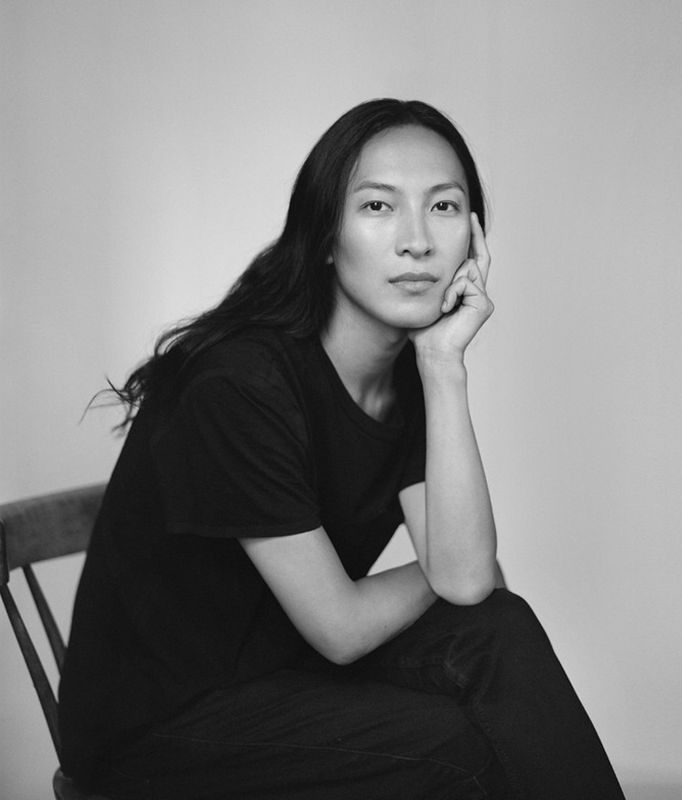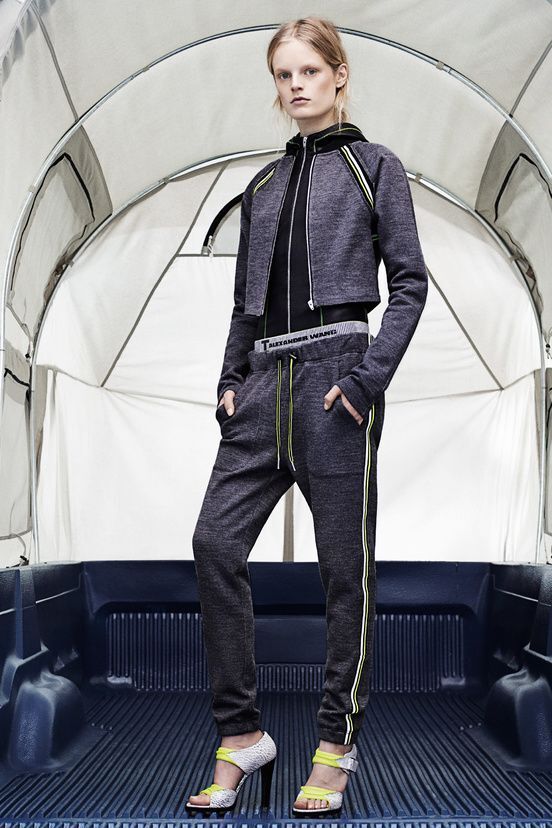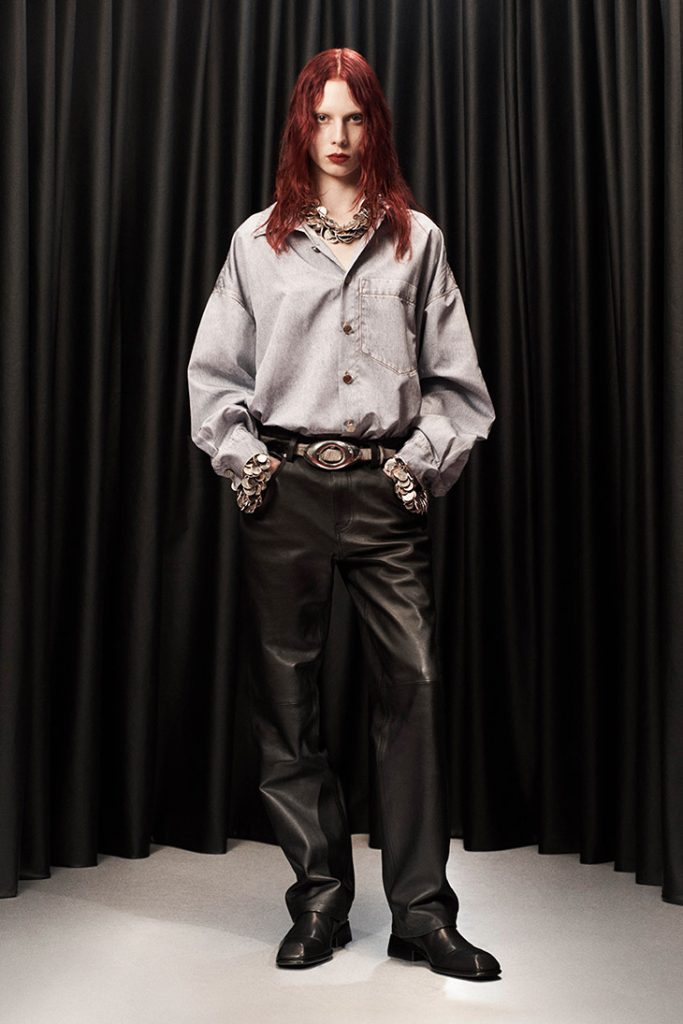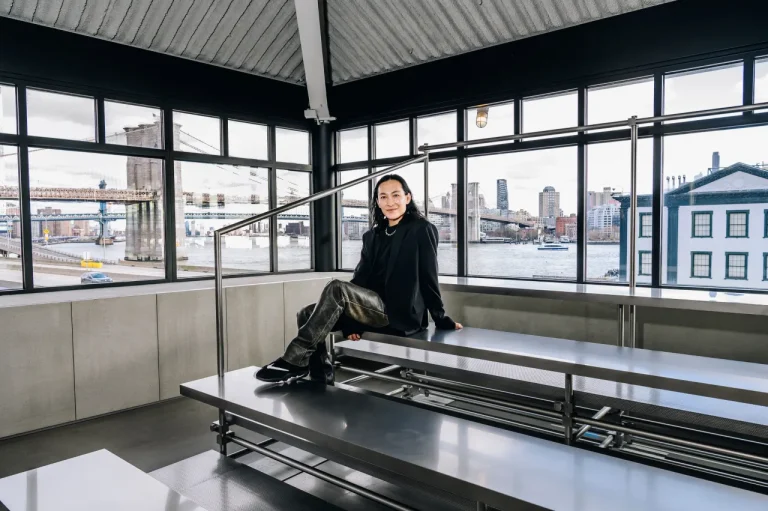
Photography by THOMAS WHITESIDE
Alexander Wang‘s journey from his nascent days in the fashion world to becoming an icon of high fashion is a remarkable story of creativity, grit, and innovation. Starting with his first unofficial presentation at a New York City warehouse, Wang’s early shows were intimate yet pulsating with the raw energy of youth and rebellion. These formative years were crucial in establishing Wang’s design philosophy, blending street sensibility with luxury, setting the tone for what his brand would become known for. His seamless transition from these humble beginnings to commanding the runways of New York Fashion Week is a testament to his visionary approach and his acute sense of what the modern consumer desires.
Alexander Wang’s fashion shows are distinguished by their unique blend of contemporary culture, music, and fashion, creating an immersive experience that goes beyond just showcasing a collection. Signature elements of Wang’s shows include a minimalist aesthetic with a strong emphasis on monochromatic color schemes, innovative use of materials, and a streetwear-inspired edge that resonates with a younger audience. For instance, his Spring 2010 collection was a pivotal moment, where Wang infused sportswear elements with luxury, introducing a new lexicon in fashion that spoke to functionality as much as style. This approach not only solidified his aesthetic but also highlighted his skill in reflecting societal shifts within his designs.
Wang’s ability to stay at the forefront of fashion is partly due to his strategic collaborations and the diverse influences he seamlessly weaves into his collections. His partnership with Adidas Originals, for example, blurred the lines between high fashion and streetwear, introducing a range of products that were both accessible and high-end. These collaborations have not only expanded Wang’s creative horizons but also allowed him to reach wider audiences, reinforcing his position as a pivotal figure in contemporary fashion. Moreover, Wang’s influences, ranging from the grunge music scene to New York City’s eclectic street style, have consistently shaped his shows, making each collection a reflection of a specific cultural moment.
The 2007 Debut: A New Dawn in Fashion
Alexander Wang’s 2007 debut was more than just a fashion show; it was a bold declaration of a new fashion ethos centered around a blend of high fashion sensibilities and streetwise pragmatism. The collection, characterized by its downtown cool vibe, laid the groundwork for what would become Wang’s signature style. This debut was crucial in establishing Wang as a designer who was not afraid to diverge from the traditional path and instead forge his own, blending elements of sportswear, minimalism, and an underlying edge of rebelliousness.
The “Athleisure” Phenomenon: 2014’s Game-Changer
In 2014, Wang catapulted the ‘athleisure’ trend into the global spotlight with his groundbreaking collection that seamlessly merged the comfort and functionality of athletic wear with the elegance and sophistication of high fashion. This collection was a turning point, not just for Wang but for the industry at large, signaling a shift towards more versatile, lifestyle-oriented fashion. The success of this collection underscored Wang’s ability to anticipate and mold fashion trends, solidifying his status as a trendsetter.
The Spring 2018 show was a quintessential Alexander Wang experience, transforming a dead-end street in Brooklyn into an electrifying runway cum block party. This event epitomized Wang’s knack for creating buzzworthy moments that blur the lines between fashion, culture, and entertainment. The collection itself, with its innovative take on corporate wear interspersed with Wang’s signature sporty aesthetic, was a commentary on the evolving dynamics of work and leisure, showcasing his ability to tap into the cultural zeitgeist.
Wang’s innovative use of unconventional spaces for his fashion shows has redefined the concept of a runway, turning each presentation into a cultural event. From the grandeur of the Brooklyn Navy Yard to the raw, industrial vibe of a Bushwick warehouse, Wang’s choice of venues reflects his edgy, urban aesthetic and his commitment to creating immersive experiences. These spaces, often outside the traditional fashion districts, not only provide a unique backdrop for his collections but also symbolize Wang’s departure from convention, offering a fresh perspective on how and where fashion can be experienced.
Integrating Cutting-Edge Technology in Presentation
Wang’s shows often feature a fusion of fashion and technology, utilizing cutting-edge techniques to enhance the presentation of his collections. The integration of LED screens, interactive installations, and even the use of drones in some of his shows has not only added a futuristic element to his presentations but also demonstrated Wang’s forward-thinking approach to fashion. This blend of technology and design not only enriches the viewer’s experience but also positions Wang at the intersection of fashion innovation and technological advancement.
Virtual Reality and Livestreams: Expanding Audience Reach
Embracing the digital age, Wang has utilized virtual reality and livestreams to bring his fashion shows to a global audience, democratizing access to what was once an exclusive event. This strategic use of digital platforms has allowed fans and fashion enthusiasts from around the world to experience the energy and excitement of a Wang show in real-time, breaking down geographical barriers and making high fashion more accessible to a wider audience. This approach not only amplifies the reach of his shows but also reflects Wang’s understanding of the digital landscape and its potential to transform the fashion industry.

Défilé T by: Automne-hiver 2014-2015
Courtesy of Vogue

Kendall Jenner, 21 Savage, and Bella Hadid for the AW Fall 2017 campaign
Photography by JUERGEN TELLER
Gothic and Punk Influences: Rebellious Aesthetics
Wang’s collections often draw inspiration from gothic and punk subcultures, infusing his designs with a sense of rebellion and nonconformity. This influence is evident in his use of leather, metal hardware, and deconstructed silhouettes, creating a gritty, edgy look that resonates with a youthful, rebellious spirit. The Fall 2016 collection, for instance, with its dark, moody palette and punk-inspired accessories, showcased Wang’s ability to reinterpret subcultural aesthetics within a high fashion context, offering a fresh take on rebellion and individuality.
Deconstructing Americana: A Fresh Perspective
Wang’s exploration of Americana, particularly in his Spring 2017 collection, presented a deconstructed view of American iconography, from bandana prints to football jerseys. This collection dissected the traditional symbols of American culture, reassembling them in a way that challenged their conventional meanings. Wang’s reinterpretation of these motifs, blending them with his urban, streetwear-infused aesthetic, offered a commentary on the evolving identity of American fashion, highlighting his talent for merging cultural analysis with design.
Blurring Gender Boundaries: Androgyny in Design
Alexander Wang’s approach to design often includes a blurring of traditional gender boundaries, advocating for a more fluid expression of identity through fashion. His androgynous silhouettes and unisex pieces challenge the conventional norms of menswear and womenswear, promoting a vision of fashion that is inclusive and liberating. This ethos is reflected in collections that feature a mix of oversized garments, gender-neutral tailoring, and a subtle interplay of masculine and feminine elements, encouraging individuals to express their identity in diverse and unconventional ways.
Star-Studded Runways and Front Rows
Wang’s fashion shows are renowned for their celebrity appeal, with A-listers often gracing the runways and front rows. This fusion of fashion with celebrity culture not only amplifies the visibility of his collections but also underscores the deep connections between Wang’s brand and the broader entertainment industry. Celebrities like Rihanna, who has both walked in his shows and attended as a guest, exemplify this synergy, blurring the lines between fashion, music, and celebrity, and elevating the brand’s status within the pop culture lexicon.
Music and Fashion: An Interwoven Narrative
Music plays a central role in Wang’s fashion shows, with carefully curated playlists and live performances that create a vibrant atmosphere and enhance the thematic elements of each collection. This interplay between music and fashion is a signature aspect of Wang’s presentations, reflecting his belief in the power of music to evoke emotions and connect with audiences on a deeper level. The inclusion of artists and genres that resonate with the youthful energy and rebellious spirit of his brand reinforces Wang’s shows as not just fashion presentations but as cultural happenings.
Influencer Collaborations and Social Media Buzz
Wang’s adept use of social media and collaborations with influencers has played a significant role in building the brand’s identity and reach. By partnering with influential figures in the fashion and entertainment industries, Wang has tapped into their vast networks, generating buzz and anticipation for his shows. This strategy, combined with his active presence on platforms like Instagram, has allowed Wang to cultivate a community of followers who are engaged, loyal, and eagerly await each new collection. This modern approach to marketing and brand building exemplifies Wang’s understanding of the digital landscape and his ability to leverage it to enhance the brand’s profile.
Navigating the Challenges of Modern Fashion
The fashion industry is no stranger to controversy, and Alexander Wang has faced his share of challenges and criticisms over the years. From allegations of unfair labor practices to disputes over design originality, Wang has had to navigate the complex waters of the fashion world. These controversies have sparked important conversations about the responsibilities of designers and the ethical considerations of fashion production, underscoring the need for transparency, fairness, and innovation in addressing these issues.
Addressing Criticisms and Adapting to Change
In response to critiques, Wang has shown a willingness to evolve and address concerns head-on. Whether it’s adopting more sustainable practices, engaging in more inclusive casting for his shows, or reevaluating his design and production processes, Wang’s approach to criticism is reflective of a broader movement within the fashion industry towards greater accountability and ethical responsibility. This adaptability not only speaks to Wang’s resilience as a designer but also to his commitment to growth and improvement in the face of adversity.
The Future Path: Sustainability and Ethics in Fashion
As the fashion industry grapples with issues of sustainability and ethical production, designers like Alexander Wang are at the forefront of this transformative period. The increasing emphasis on eco-friendly practices, fair labor conditions, and ethical sourcing presents both a challenge and an opportunity for Wang to lead by example. By integrating sustainable materials, embracing ethical manufacturing processes, and fostering transparency in his supply chain, Wang has the potential to set new standards in the industry, contributing to a more responsible and conscientious approach to fashion.
Influence on Contemporary Fashion and Upcoming Designers
Alexander Wang’s impact on the fashion industry extends far beyond his collections. As a trailblazer who has consistently pushed the boundaries of design, Wang has influenced not only contemporary fashion but also inspired a new generation of designers. His approach to blending streetwear with high fashion, his innovative use of materials and technology, and his ability to capture the cultural zeitgeist have made him a pivotal figure for aspiring designers looking to make their mark. Wang’s legacy is one of creativity, innovation, and an unwavering commitment to redefining the possibilities of fashion.
Anticipating the Next Chapter in Wang’s Fashion Journey
As Alexander Wang continues to evolve and expand his brand, the fashion world watches with keen interest. With each new collection, Wang has the opportunity to explore new themes, experiment with emerging technologies, and respond to the shifting dynamics of the industry. The anticipation surrounding what Wang will do next is a testament to his enduring influence and the excitement his work generates. Whether it’s delving deeper into sustainability, exploring new forms of digital engagement, or challenging conventional notions of fashion, Wang’s future endeavors are sure to captivate and inspire.
Adapting to a Changing Fashion Landscape
The fashion landscape is constantly evolving, shaped by technological advancements, shifting consumer values, and global trends. In this ever-changing environment, Alexander Wang’s ability to adapt and innovate is crucial to his continued relevance and success. As sustainability becomes increasingly important, Wang’s engagement with eco-friendly practices and materials will be closely watched. Similarly, as digital platforms and virtual reality become more integrated into the fashion experience, Wang’s willingness to embrace these technologies will play a key role in defining his brand’s future. In an industry characterized by rapid change, Wang’s capacity for reinvention and his commitment to pushing the boundaries of fashion will ensure that his brand remains at the forefront of design innovation.

Resort 2024 campaign
Courtesy of ALEXANDER WANG

